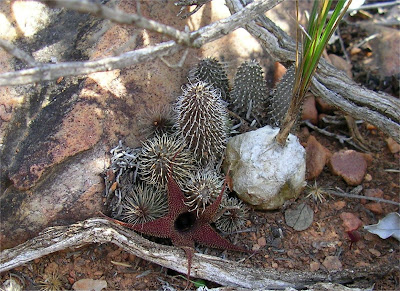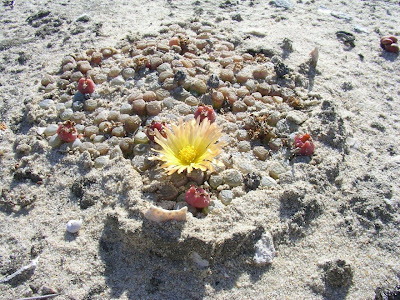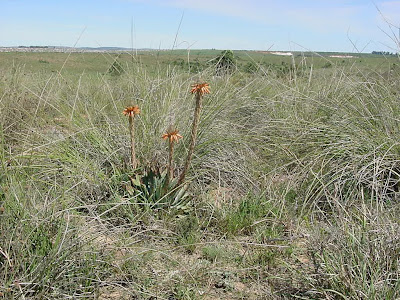This beautiful Dioscorea plant is found in the Clanwilliam district, as well as on the desert mountain slopes of the Graaff-Reinet, Klipplaat, Willowmore and Uniondale districts. It is possible that Dioscorea elephantipes also grows in the Tanqua Karoo and elsewhere. Dioscorea elephantipes in cultivation.
Dioscorea elephantipes in cultivation.
Dioscorea elephantipes is somewhat similar to Dioscorea hemicrypta from the Western - and Eastern Cape, but often has a neater appearance. The bark of elephantipes is also usually more deeply fissured, the plant body somewhat ovoid shaped and the leaves more fleshy.
Dioscorea elephantipes, similar to hemicrypta lose their leaves during the hot summer months.
Common names include Yam, Wild Yam, Elephant's Foot, Turtle Back, Hottentot's Bread
Synonyms: Jade Plant, Money Tree Plant, Money Plant,Pink Joy (Afr: Beestebul)
Distribution: Eastern Cape, Kwazulu-Natal
The Jade plant is a very popular and easy to grow garden plant. It occurs in natural habitat from the desert regions of Willowmore easterwards and northwards into the areas with a more temperate climate.
Crassula ovata can easily be propagated from stem cuttings and leaves, which root readily.
Some pictures of old Jade Plant Large Money Plant
Fresh seed of Nymania capensis (Klapperbos) available here:
Nymania capensis is native to the dry southern and western parts of South Africa and also occurs in southern Namibia.
The plants are particularly attractive in winter and early spring when when producing fruit in the shape of small Chinese lanterns. They form small desert trees and can withstand considerable periods of drought.
The Chinese lantern is pollinated by bees . When the fruit ripens the puffy capsules containing the seed are blown off the plant and carried by the wind some distance away from the parent plant.
The plants can be grown from seed which can be sown in autumn or early spring.
Veltheimia capensis is very similar to Veltheimia bracteata. Although in the case Veltheimia capensis the bulb is supposedly partly exposed above the ground, I have not seen this feature in plants from the Oudtshoorn area.
I have found them growing exposed on hill sides but also in deep shape under bushes.
Veltheimias grow and flower in winter.
Propagation is from seed or off shoots.
Aloe speciosa (speciosa means "showy") is exceptionally common in the south-western and south-eastern Cape in South Africa. It is a beautiful semi-desert Aloe and rewarding to grow as it is quite easy to cultivate.
The perianth of Aloe speciosa changes color from red to whitish green while maturing. The blackish-brown inner parts of the flower add to the striking color variation of the flowers.
The synonyms for Aloe speciosa include Tilt-head Aloe, (Afr: Slaphoringaalwyn, Spaansaalwyn).
The plants hydridize freely with other Aloes when sharing their habitat.
Seedlings form Aloe speciosa are available from Izimakana Industries. Aloe speciosa in cultivation.
Aloe speciosa in cultivation.
 Aloe speciosa flowers.
Aloe speciosa flowers.
There are however notable differences in especially the flowers and roots of the plants, which necessitates it being kept a unique species. Haworthia bruynsii is rather difficult to cultivate and requires careful watering and good drainage of the soil.
The flowers are similar to others in the genus.
Haworthia kingiana is found growing amongst shrub in the Great Brak River and Little Brak River areas. This attractive Haworthia grows up to 20 cm in height , resembling plants of the closely related Genus Aloe.
Haworthia kingiana is related to some others in the genus, especially Haworthia marginata, Haworthia minima.and Haworthia maxima. See also Haworthia zenigata .
The cultivation of Haworthia kingiana is not difficult but growth is slow. Propagation is from seed.
Euphorbia albipollinifera is distinquised from similar looking Euphorbias by having white pollen instead of yellow. Another unusual feature is its peduncle which is jointed near its apex.
This small Euphorbia desert plant is found on the Springbok Flats, in the Steyterville and Kirkwood areas.
Gasteria carinata var. carinata is found in coastal areas south of the Langeberg between Mossel Bay and Hermanus. The plants prefer to grow in the shade of bushes, but are also sometimes found growing in the open. Gasteria carinata var. carinata is quite variable and the plants from some areas make it difficult to distinguish between this species and similar species e.g. Gasteria brachyphylla var. brachyphylla.
Haworthia helmiae occurs at an isolated locality at the foot of the Outeniqua mountains in the Southern Cape. It is one of many Haworthia species that have enough unique characteristics to be a species in their own right, but also show affinity with other species.
So far Haworthia helmiae, seems very localised.
M.B. Bayer regards Haworthia helmiae as a form of Haworthia outeniquensis.
Euphorbia meloformis (meloformis means "looking like an apple") is found in the Port Elizabeth, Uitenhage and Albany districts. This beautiful octagonal Euphorbia is normally found in pebbly grasslands , half sunk into the soil and well camouflaged by its surroundings.
The plants are related to the well known Euphorbia obesa , as well as to Euphorbia valida and Euphorbia symmetrica. Superfically there is some resemblance to the American pentagonal cactus, Astrophytum myriostigma, or "Bishops Cap". Genetically as well as geographically the two species are however miles apart. The latter belonging to the family Cactaceae. It does however illustrate how two different plant families make similar adaptations to withstand the conditions under which they survive.
Euphorbia decepta is an interesting and very attractive small Euphorbia species. The globose body protrudes mainly above the ground. The short little fingers and general appearance of this Euphorbia species is shared by some other Great Karoo Euphorbias, e.g.: Euphorbia crassipes, Euphorbia suppressa and some undescribed ones.
The distribution area of Euphorbia decepta is in the south eastern Great Karoo.
Propagation is from seed.
Unlike other Aloes, Aloe longistyla is usually found growing scattered about and not in groups. This could perhaps be because of the relatively large papery "wings" on the seed, increasing travel distance when the wind blows
Aloe longistyla is difficult to cultivate when taken out of the wild.
Propagation is from seed. Suckers from cultivated plants can also be used.
Aloe chlorantha is only known from the Fraserburg and Sutherland areas of the Great Karoo, where it grows on dry northern slopes of hillsides. The plants have small yellowish-green flowers. Aloe chlorantha shows some affinity with Aloe broomii and Aloe gariepensis.
Aloe chlorantha is a rare species and regarded as endangered. The flowering time of Aloe chlorantha is in October. Aloe chlorantha in habitat near Frazerburg.
Aloe chlorantha in habitat near Frazerburg.
Family: Apocynaceae
Distribution: Great Karoo, Free State
Photographs: Desert Plants
This stapeliad is found in the central and northern Karoo as well as the Free State. It has a distinct beard on the annulus and the flowers, with a diameter of about 50 mm. are larger then other Duvalias of southern Africa. Duvalia corderoyi in cultivation. Photographer: Gerhard Marx
Duvalia corderoyi in cultivation. Photographer: Gerhard Marx
The flower colour varies from a dull red to a very attractive scarlet-red. Aloe comptonii is found from about Montaque in the west, right through the semi-desert Little Karoo, to Uniondale in the East. While young plants grow erect, older plants tend to develop a stem that creeps on the ground.
Aloe comptonii is quite easy to cultivate if conditions are similar to those of its natural environment. The plants do not like frost. This Aloe is well able to withstand the desert-like conditions of the Little Karoo. In gardens however, the plants do not seem to mind considerably larger amounts of water, as long as the plants are on a raised bed with good drainage.
In its natural habitat Aloe comptonii flowers from August to January. Some plants were found near Calitzdorp that had already set seed in October, while plants from south of Oudtshoorn, only some 50 km to the east, had not even started flowering yet.
Aloe comptonii merges into Aloe mitriformis at its western distribution range.
The following two photographs were taken in Cogmanskloof between Ashton and Montaqu.
Family: Apocynaceae
Distribution: Little Karoo, southern Great Karoo
Photographs: Desert Plants
A small and attractive stapeliad. The stems are covered with small soft bristles. In its natural habitat in the Little Karoo the plants grow protected under bushes. The subspecies extents northwards to the Laingsburg district. Huernia pillansii subspecies pillansii in habitat near Calitzdorp. A charming little desert plant showing off its reddish-brown flowers. Photographer: Gerhard Marx
Huernia pillansii subspecies pillansii in habitat near Calitzdorp. A charming little desert plant showing off its reddish-brown flowers. Photographer: Gerhard Marx
Distribution: Arid areas of South Africa, Namibia
Images: Desert Plants
Found over a wide area from the Little Karoo northwards to South eastern Namibia. It is a smallish Crassula, and normally grows in the open. Plants appear on their best when grown in the full sun.
This tiny desert plant has fleshy white mealy-coated leaves for protection against the sun.
Ceropegia fimbriata subspecies geniculata
Family: Apocynaceae
Distribution: Little Karoo
Images: Desert Plants Ceropegia fimbriata subspecies geniculata in habitat near Oudtshoorn. Photographer: Gerhard Marx.
Ceropegia fimbriata subspecies geniculata in habitat near Oudtshoorn. Photographer: Gerhard Marx.
First collected by A.J.Joubert 1973 in the Van Wyksdorp district, it was described by R.A. Dyer as Ceropegia geniculata. It is now regarded as a subspecies of Ceropegia fimbriata. Because of their growing habit, often entangled in bushes, Ceropegias are not easy to find in the wild.
Aloe ferox occurs widely in South Africa. Many plants grow up to 5 meters tall, but there is variablity in size over the distribution area of the plants. Aloe ferox prefers to grow in semi-desert or other relatively arid regions.
The flower colors are mainly bright red, orange and yellow, but occasionally white flowers are found. Flowering time is normally from May to August, but flowering of Aloe ferox occurs later in the northern parts of South Africa.
Cape Aloes is a product made from the leaf sap from Aloe ferox and has been used for over 200 years mainly as a purgative. Recently new applications have been introduced e.g. pain relieve in rheumatism and arthritis.
The habitat of Aloe ferox often overlaps with that of Aloe speciosa , the varieties Aloe lineata and several others. Hybrids are common.
The propagations is from seed and the plants are easy to cultivate.
Although Aloe pillansii resembles Aloe dichotoma in general appearance, it is a much larger tree Aloe and can grow to a height of over 10 meters.
The most significant difference between the two tree Aloes is that whereas A dichotoma has flowers that stand upright. the yellow flowers of Aloe pillansii bend down under the crown of leaves. Aloe pillansii is less branched then the other and the branches are erect.
Aloe pillansii is a rare species and regarded as endangered.
Aloe pillansii is also known as Bastard Quiver Tree.
The propagation is from seed which is not readily available. The plants like hot and dry conditions with a well drained soil.
Family: Aizoaceae
Distribution: Coastal Namib Desert, North- western Richtersveld
Images: Desert Plants
Previously known as Fenestraria aurantiaca, this is a real desert plant found in the coastal sand from Luderitz Bay to just south of the Orange River. It is an unusual species and well adapted to the harsh conditions of its environment. Fenestraria rhopalophylla subspecies aurantiaca almost invisible under the sand with only the leaf tips exposed.
Fenestraria rhopalophylla subspecies aurantiaca almost invisible under the sand with only the leaf tips exposed.
The leaves have transparant tips allowing sunlight to enter the plant. The elongated plant bodies are half - to completeley buried in the sand for maximum protection from the sun. Only the leaf tips are exposed to the sunlight. Fenestraria rhopalophylla subspecies aurantiaca in flower.
Fenestraria rhopalophylla subspecies aurantiaca in flower.
The area receives regular morning mist which is the main contributor to the survival of the plants. The flowers are yellow.
Hoodia pilifera spp. annulata was previously known as Trichocaulon annulatum This is the largest growing Hoodia in South Africa. The size depends somewhat on the locality where they come from. Some plants reaching a mass of 200 kg have been recorded.
Hoodia pilifera spp. annulata occurs in semi-desert areas of the Willowmore and Jansenville districts of the Eastern Cape and make a beautiful display when in flower. This is one of the species that the Bushmen regard as "ghaap".
The cultivation is similar to most others in the genus, with good light and drainage, as well as a dry period between waterings.
An adult plant in habitat.




